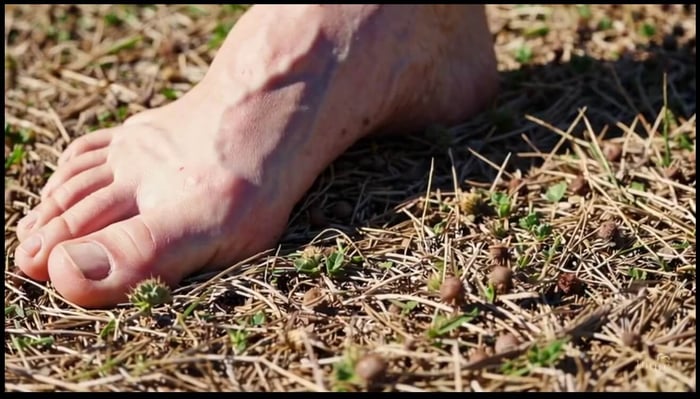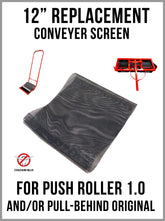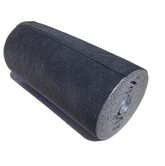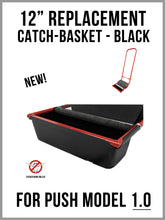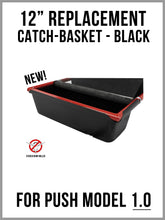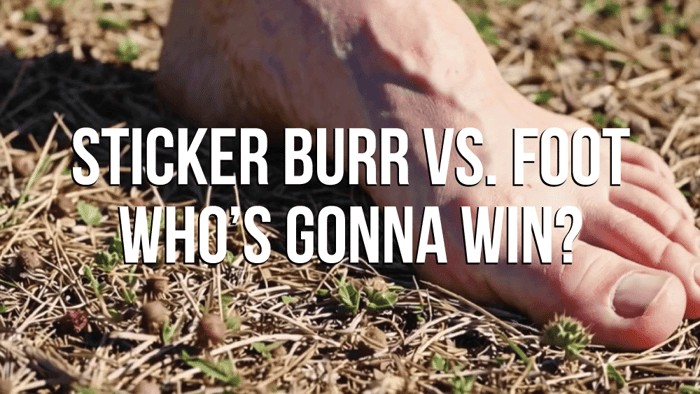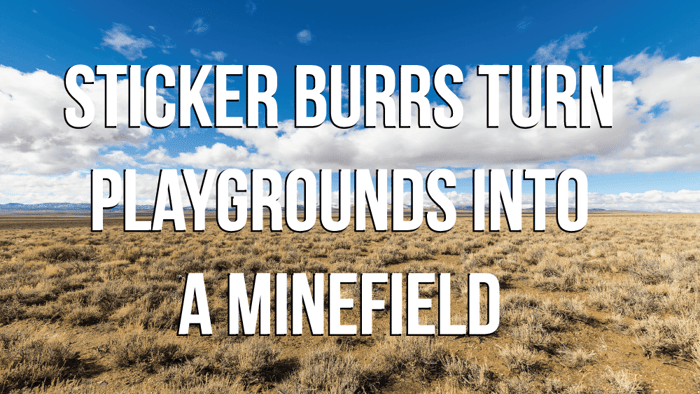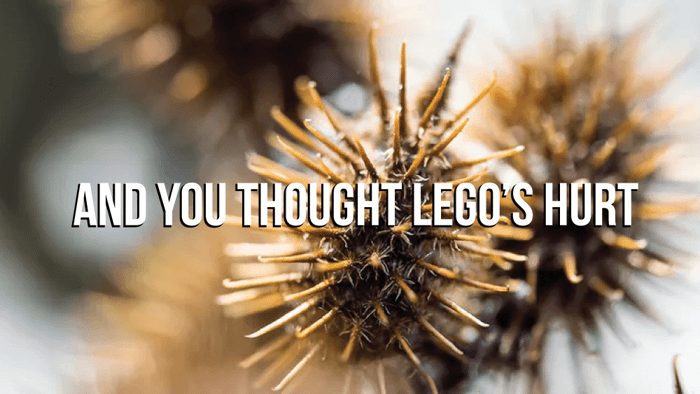These little buggers might be tiny, but they are ground level assassins, perfectly geared for ruining shoes, irritating pets and overtaking lawns. These spiny invaders are a common nuisance for homeowners, adventurers, and pet lovers alike.
In this comprehensive guide, we’ll cover everything you need to know about sticker burrs—what they are, how they spread, and, most importantly, how to get rid of them for good.
What Are Sticker Burrs?
Often referred to as puncturevine seeds or grass burrs, are sharp, spiny seed pods produced by certain weeds. These plants have evolved to spread their seeds by clinging to anything they touch—shoes, tires, pet fur, or even bare skin.
Common Sticker Burr Plants Include:
- Puncturevine (Tribulus terrestris): Known for its hard, thorny seeds that resemble goat heads.
- Sandburs (Cenchrus spp.): Grass-like weeds found in sandy soils.
- Burweed (Soliva sessilis): Common in lawns and parks, with small burrs hidden beneath the foliage.
How Do They Spread?
Sticker burrs are designed for survival. Their spines latch onto passing animals, shoes, and even the wind to travel far from their parent plant. This efficient dispersal method makes them one of the most persistent weeds to control.
Key Factors in Their Spread:
- Human Activity: Sticker burrs hitchhike on clothing and equipment, spreading to new areas.
- Animal Movement: Pets and wildlife often carry burrs in their fur, inadvertently planting them elsewhere.
- Lawn Equipment: Mowers can pick up and scatter seeds across your yard.
Why Are They SUCH a Problem?
The problems caused by sticker burrs go far beyond minor annoyance.
- Harm to Pets: Sticker burrs can lodge in a pet’s paws, causing pain, limping, or even infections if not removed promptly.
- Damage to Gear: From punctured bike tires to torn clothing, sticker burrs can wreak havoc on outdoor equipment.
- Lawn Takeover: Left unchecked, sticker burrs can quickly overrun your yard, making it uncomfortable and unsafe for use.
- Painful Encounters: Barefoot walkers and hikers often discover sticker burrs the hard way, as their sharp spines pierce skin.
Sticker Burrs Through the Seasons
They behave differently throughout the year, which can affect your approach to removal and prevention.
- Spring: Seeds germinate, and plants grow rapidly. This is the best time to apply pre-emergent herbicides.
- Summer: Plants mature, flower, and produce seed pods. Early intervention is key.
- Fall: Burrs drop to the ground, ready to spread or lie dormant. Remove plants before they seed.
- Winter: Seeds remain dormant but viable, waiting for favorable conditions.
Pro Tip: Consistent effort across seasons is essential to breaking the sticker burr cycle.
How to Identify Sticker Burr Plants
Identifying sticker burr plants early is key to preventing their spread.
- Leaves: Most sticker plants have small, feathery leaves that grow close to the ground.
- Flowers: They often produce tiny yellow, white, or green flowers.
- Seeds: The most recognizable feature is their spiny seed pods, which form after flowering.
Where to Look:
Sticker plants thrive in sunny, dry areas with poor soil. Common places include:
- Lawns
- Playgrounds
- Bike trails
- Campsites
How to Take Back Your Yard
The good news is that you can fight back with the right tools and strategies!
1. Remove Sticker Burr Plants Manually
Pulling weeds by hand is one of the most effective ways to control this invasive species, especially if you catch them early.
Steps for Manual Removal:
- Wear gloves to protect your hands.
- Use a weeding tool to ensure you remove the entire root system.
- Dispose of plants carefully to prevent seeds from spreading.
2. Use the Sticker Burr Roller
The Sticker Burr Roller is a game-changing tool that makes removing burrs quick and easy.
Why It’s Effective:
- Picks up burrs from grass, gravel, and hard surfaces.
- Saves time compared to manual removal.
- Eco-friendly—no chemicals required.
Customer Testimonial:
"The Sticker Burr Roller saved me hours of work! My yard is finally burr-free, and my dog can run around without getting hurt."
3. Improve Lawn Health
A healthy lawn is your best defense against sticker burrs.
Lawn Care Tips:
- Mow Regularly: Keep grass at the recommended height for your lawn type to prevent weed growth.
- Fertilize: Feed your lawn with the nutrients it needs to thrive.
- Aerate and Overseed: Fill in bare spots to crowd out weeds.
4. Apply Pre-Emergent Herbicides
Pre-emergent herbicides prevent sticker burr seeds from germinating.
When to Apply:
- In early spring before temperatures consistently exceed 55°F (12.7°C).
Pro Tip: Always read and follow the label instructions for safe and effective herbicide use.
5. Disposing of them Properly
After collecting sticker burrs, dispose of them in sealed bags. Avoid composting, as seeds may survive and spread.
Eco-Friendly Alternatives for Removal
Looking for chemical-free options? These eco-friendly methods can help you manage sticker burrs sustainably:
- Solarization: Cover infested areas with clear plastic to trap heat and kill seeds.
- Vinegar Spray: Use a natural herbicide made from vinegar and water on young plants.
- Mulching: Suppress weed growth by covering soil with organic mulch.
Myths Debunked
Myth: Sticker burrs only grow in neglected lawns.
Fact: They can thrive anywhere, even in well-maintained lawns with thin grass coverage.Myth: Sticker burr seeds die in winter.
Fact: Seeds can remain dormant but viable for up to five years.Myth: Removing burrs is impossible without chemicals.
Fact: Tools like the Sticker Burr Roller offer a chemical-free solution.
FAQs
Q: How long do the seeds remain viable?
A: Sticker burr seeds can remain dormant in soil for up to five years, making consistent control efforts essential.
Q: Can they harm my pets?
A: Yes, they can cause pain and even infections if lodged in a pet’s paws or fur. Always check your pets after outdoor activities.
Q: What’s the best tool for removing them?
A: There are a few options on the market, but the Sticker Burr Roller is one of the most efficient tools for removing burrs from lawns, driveways, and other surfaces.
They may be persistent, but they’re no match for a well-informed homeowner armed with the right tools and strategies. By understanding their life cycle, identifying plants early, and using solutions like the Sticker Burr Roller, you can enjoy a burr-free yard and outdoor adventures.
Take control of your lawn today and say goodbye to sticker burrs—because a healthy, happy yard is worth the effort.
www.StickerBurrRoller.com
